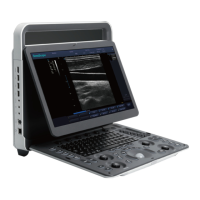10 Probes and Biopsy Brackets
126 Basic User Manual
10.1.4 Disinfecting or Sterilizing the Probe
●
There is a cleared list of sterilants and high-level disinfectants for use in processing
reusable medical and dental devices on the FDA website. That list can be consulted
to find agents that may be useful for probe disinfection. Please refer to the following
URL for FDA-Cleared Sterilants and High Level Disinfectants: http://www.fda.gov/
MedicalDevices/DeviceRegulationandGuidance/ReprocessingofSingle-UseDevices/
ucm133514.htm.
●
Use the liquid disinfectant/sterilant that meets local laws and regulations or the
recommended disinfectant/sterilant.
●
The probe sheath may be damaged during exam and contamination risk level caused
by the damaged sheath is difficult to estimate. Therefore, probe sheath cannot change
the level of disinfection for a probe. Please clean and sterilize (or high level disinfect)
the endocavitary probe and clean and sterilize the probe for biopsy and coming into
contact blood after exam.
Do not use an expired disinfectant/sterilant.
Store the probe in a sterile environment, and review its expiration date before use.
●
If you use the recommended disinfectant/sterilant, ensure the requirements for the
disinfection level and probe soaking period are met. Otherwise, the probe could be
damaged and your warranty might be void. If you have further use or needs for the
probe, ensure the level of the make-up disinfectant/sterilant and the probe soaking
period are suitable for the intended clinical application.
Do not use the following methods to sterilize the probe.
−
Autoclave
−
Ultraviolet sterilizer
−
Gamma ray sterilizer
−
Ethylene oxide gas
−
Ethylene oxide
−
Thermal disinfection/sterilization. Temperature higher than 66°C (150°F) will
damage the probe.
Do not allow any disinfectant/sterilant to be air-dried on the probe.
■ Disinfection Levels
To choose an appropriate disinfectant, you must first determine the required level of
disinfection, based on the probe classification.

